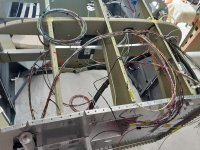PaulvS
Well Known Member
The Dynon harnesses for the EMS and EFIS have more wires and longer wires than needed for my installation. I'm wondering how people have dealt with the excess, e.g. cut off and discard, or tie up into loops and store somewhere up behind the panel? Neither of the popular books (Aeroelectric Connection, Aircraft Wiring Guide) or the Dynon manual seem to cover this, but there must be a "good" way to do it.





